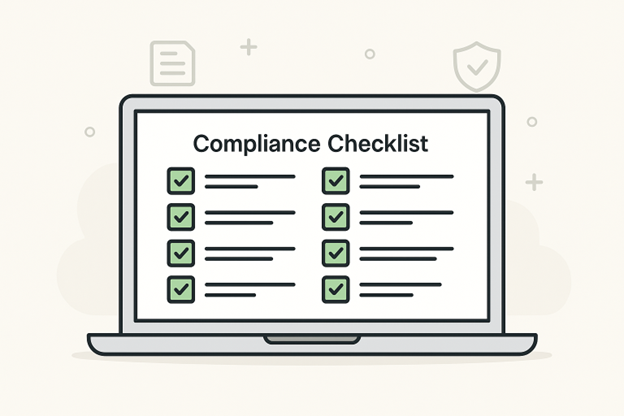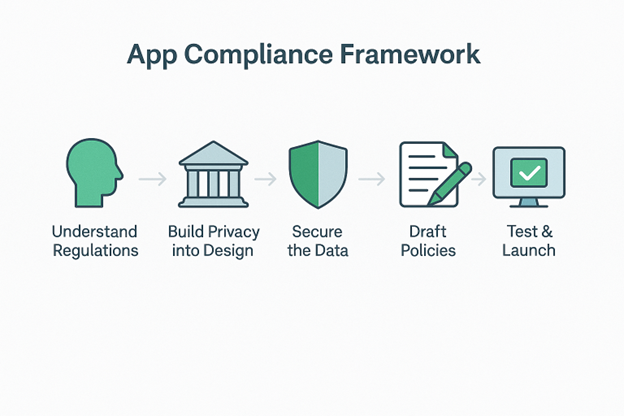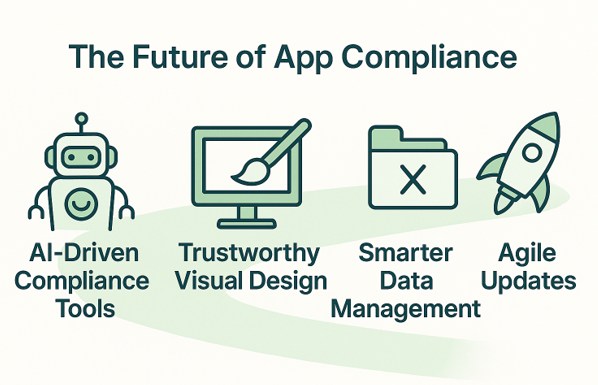Building an app today is not just about writing clean code or crafting a beautiful UX. It’s about trust, security, and, increasingly, legal compliance. Whether you’re aiming for the European market (GDPR), healthcare (HIPAA), or global scalability, compliant app development is a non-negotiable part of your strategy.
In this guide, you’ll find practical, step-by-step advice on how to build legally compliant apps, backed by real-world insights from experts. Let’s dive in.
What Does Compliant App Development Mean?
Compliant app development refers to the process of designing, developing, and deploying applications that fully adhere to relevant legal, regulatory, and industry standards. Think GDPR for user data, HIPAA for medical information, CCPA for California residents, and many others.
As Daniel Solove, a leading authority on information privacy law, puts it: “Compliance is not a checklist; it’s a culture.”
Building this culture into your app from the ground up is essential.

Why Compliant App Development Matters Across Industries
Compliance isn’t just for healthcare or finance. Every industry is feeling the pressure:
- E-commerce apps must comply with PCI DSS for secure payments.
- Educational apps handling student data are subject to FERPA.
- Real estate apps managing client data must consider GDPR and CCPA.
- Fitness and wellness apps often deal with sensitive health data, even if they’re not HIPAA-covered entities.
Regardless of the sector, a failure to build a compliant app can severely harm your reputation and finances.
Step 1: Understand the Relevant Regulations
Before you write a single line of code, identify which regulations apply to your app:
- GDPR (General Data Protection Regulation) for EU citizens’ data. Read the GDPR requirements
- HIPAA (Health Insurance Portability and Accountability Act) for handling healthcare data. Explore HIPAA standards
- CCPA (California Consumer Privacy Act)
- PCI DSS (Payment Card Industry Data Security Standard) for payment apps
- SOX (Sarbanes-Oxley) for financial transparency
Pro Tip: If you’re unsure, consult with a compliance expert early.
Step 2: Implement “Privacy by Design”
“Privacy by Design” means thinking about data protection at every stage:
- Minimize data collection: Gather only what you absolutely need.
- Anonymize and encrypt personal data.
- Clear consent: Users must clearly agree to data collection and usage.
“Privacy should be the default setting.” — Ann Cavoukian, creator of the Privacy by Design framework
Incorporate privacy into your app architecture, not as an afterthought.
Step 3: Secure the Data
Security and compliance go hand-in-hand. Here are must-dos:
- End-to-end encryption for data in transit and at rest.
- Multi-factor authentication (MFA) for user accounts.
- Regular security audits and vulnerability assessments.
Consider partnering with network and security solutions experts if you lack in-house security specialists.
Step 4: Create Transparent Policies
Your users need to know:
- What data you collect
- How you use it
- Who you share it with
- Their rights (deletion, access, portability)
Draft easy-to-understand privacy policies and terms of service. Avoid legalese; be clear and transparent.
Step 5: Data Management and Archiving
Effective data archiving software is vital. It helps:
- Maintain records for audits
- Ensure disaster recovery
- Support user rights (e.g., right to erasure under GDPR)
Good archiving reduces legal risks and boosts operational efficiency.
Step 6: Consent Management
Building a legally compliant consent mechanism is critical:
- Granular consent (users opt in to specific types of data use)
- Easy withdrawal (users can revoke consent at any time)
- Detailed logging (keep records of consent)
Many modern apps use a “preference center” for user-controlled privacy settings.
Step 7: Vendor and Third-party Management
If your app relies on third parties (analytics tools, payment processors), ensure they are compliant too. Your app’s compliance can be compromised by a non-compliant vendor.
Use methods like Gabor Granger analysis to select reliable, user-friendly partners.
Step 8: Build a Data Breach Response Plan
No system is 100% secure. Prepare for breaches:
- Detection: Monitor for suspicious activity.
- Notification: Inform users and regulators within required timelines.
- Mitigation: Act quickly to contain the breach.
GDPR requires notifying authorities within 72 hours. HIPAA has its own strict breach notification rules.
Step 9: Regular Compliance Audits
Compliance isn’t “set it and forget it.” Conduct:
- Quarterly self-audits
- Annual external audits
- Ongoing risk assessments
An experienced Excel macro consultant can help automate audit reporting and data analysis.
Step 10: User Empowerment
Empower users by giving them control over their data:
- Easy data export tools
- Quick account deletion processes
- Visible privacy dashboards
This builds trust and can become a key selling point.
“Giving users true control over their data will be the hallmark of trustworthy apps in the future.” — Bruce Schneier, cybersecurity expert
Step 11: Specific Compliance Challenges by Industry
Each industry presents its own compliance hurdles:
- Healthcare apps must safeguard Protected Health Information (PHI) according to HIPAA.
- Finance apps must implement Know Your Customer (KYC) checks and Anti-Money Laundering (AML) compliance.
- Education apps targeting minors need to comply with COPPA (Children’s Online Privacy Protection Act).
- Retail apps face GDPR fines if they do not honor “right to be forgotten” requests properly.
Tailor your compliance strategy to the industry you’re operating in.
Step 12: Integrating Compliance into Agile Development
Modern app development often follows agile methodologies. Here’s how to blend compliance into fast-moving environments:
- Add “compliance user stories” into sprint planning.
- Use compliance checklists during code reviews.
- Run “privacy impact assessments” during design stages.
By embedding compliance at every iteration, you avoid costly reworks later.

Compliance Checklist Before Launch
Before releasing your app to the public, it’s crucial to ensure it meets all legal and regulatory requirements. Here’s a simple checklist to guide you:
- Privacy Policy
- Draft and display a clear, accessible privacy policy.
- Explain how user data is collected, used, and stored.
- Ensure it complies with GDPR, CCPA, or other regional laws.
- Terms and Conditions
- Create detailed terms of service outlining user rights, app rules, and liability limits.
- Data Security Measures
- Implement encryption for sensitive data.
- Regularly conduct vulnerability scans and penetration tests.
- Secure APIs and third-party integrations.
- User Consent and Permissions
- Obtain explicit consent for data collection (opt-in, not opt-out).
- Provide users with easy-to-manage privacy settings.
- Compliance with Specific Regulations
- GDPR (EU) for data protection and privacy.
- HIPAA (US) if dealing with healthcare data.
- COPPA (US) if targeting users under 13.
- PCI DSS if processing payments.
- Accessibility Standards
- Ensure your app meets WCAG 2.1 guidelines for users with disabilities.
- Third-Party Services Compliance
- Verify that all plugins, SDKs, and third-party services also comply with relevant laws.
- Audit Trails and Logs
- Maintain secure logs of data access and changes for future audits.
- App Store Guidelines
- Review and align with Apple App Store and Google Play compliance rules.
- Internal Testing and Legal Review
- Conduct a full internal compliance audit.
- Get a legal team to review your app for any hidden risks.
✅ Pro Tip: Think of compliance as an ongoing process — plan for regular updates post-launch as laws evolve.
You can also benchmark your app by comparing it with apps from top software development companies.

Streamlining Compliance Data Management
Managing compliance documentation can quickly become overwhelming, especially when dealing with user requests, audit logs, and regulatory changes. That’s why many development teams are turning to smart import/export features — for example, using tools that allow them to import JSON file to Excel to better organize privacy settings, breach logs, and consent records. Efficient data handling not only helps meet legal obligations but also enhances operational agility in fast-paced development cycles.
Embedding Compliance as a Competitive Advantage
Compliance is often seen as a burden, but forward-thinking companies view it as a powerful differentiator. By prioritizing transparent data practices, ethical AI integration, and user-first privacy features, you can turn legal obligations into unique selling points. Especially in industries like finance, education, and digital marketing, users increasingly favor apps that demonstrate respect for their rights and data. Treating compliance as part of your brand identity, not just a box to check, will future-proof your app and build lasting trust.

Future Trends: AI’s Growing Role in App Compliance
As artificial intelligence tools become more sophisticated, they are also reshaping how developers approach compliance. For example, many modern teams are now using automated solutions like a Meta Title Generator to ensure that app metadata adheres to evolving SEO and legal standards. In the near future, AI-driven compliance audits, automated data protection assessments, and real-time policy updates will likely become standard practices — making regulatory alignment faster, cheaper, and less error-prone.
Visual Trust: Why Design Matters for Compliance
A compliant app isn’t only secure under the hood — it must also look trustworthy to users. Visual elements, like clean privacy notices and intuitive consent pop-ups, can heavily influence whether users feel confident in sharing their data. Some companies even leverage business AI photos to create professional, relatable visuals that reinforce trust without the need for costly photoshoots. Small design decisions play a critical role in signaling compliance and reliability to users at first glance.
Future-Proofing Your App
Regulations evolve. Future-proof by:
- Staying updated with compliance news
- Building flexible, scalable compliance systems
- Integrating “compliance sprints” in your development cycles
Use insights on how design and data shape modern business to keep your app ahead of trends.
FAQs on Compliant App Development
- What happens if my app is non-compliant?
You risk heavy fines, legal action, and reputation damage. For instance, GDPR violations can cost up to €20 million or 4% of global revenue, whichever is higher.
- How much does compliance cost during app development?
It varies, but budgeting 10-15% of your development costs for compliance measures is a good start.
- Can compliance be added later?
Technically, yes — but it’s much harder, more expensive, and riskier. It’s smarter to build compliance from the ground up.
- Do I need a lawyer for app compliance?
While not mandatory, consulting a legal expert is highly recommended, especially if you’re handling sensitive data.
- How often should I audit my app’s compliance?
At least annually, plus after any major app updates or regulatory changes.
- What are the best tools to automate compliance tasks?
Look into services offering privacy management automation, like OneTrust or TrustArc, to streamline GDPR and CCPA requirements.
- Can small startups afford full compliance?
Yes! With strategic prioritization and focusing on core requirements first, startups can build compliant apps without breaking the bank.
Final Thoughts
Building a legally compliant app might sound daunting, but with a structured, step-by-step approach, it’s entirely achievable. By embedding compliance into your app’s DNA, you not only avoid legal pitfalls — you create a trustworthy product that users will love.
In an increasingly privacy-conscious world, compliant app development isn’t just a legal necessity; it’s a competitive advantage and a catalyst for long-term business growth.
Don’t wait until you have a problem — start your compliance journey today.



